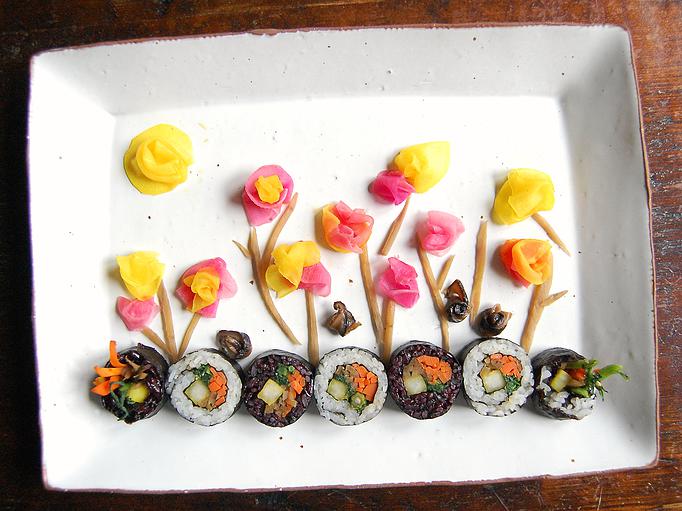Culinary Hallyu: Shin Kim’s ‘Banchan Story’ Will Bring Korean Food Lovers Together [Interview]
 You may think you know a lot about Korean food based on what you’ve eaten at the newest Korean barbecue joint in your city or what you’ve seen stars on Korean television shows. But Shin Kim thinks that a lot of Korean food aficionados are only touching on the stories and history of Korean dishes, and is kicking off a new sort of culinary-cultural fusion experience known as Banchan Story
You may think you know a lot about Korean food based on what you’ve eaten at the newest Korean barbecue joint in your city or what you’ve seen stars on Korean television shows. But Shin Kim thinks that a lot of Korean food aficionados are only touching on the stories and history of Korean dishes, and is kicking off a new sort of culinary-cultural fusion experience known as Banchan Story
Shin Kim is known from DramaFever’s “Cooking With Shin” series and the recipes from her personal blog. Now, she’s kicking off something a bit new, a new culinary experience class that she’s calling Banchan Story. With the tagline “whispers from every little dish,” Banchan Story is part Korean culture meetup, part history lesson, and all food.
Banchan Story is a way that Kim hopes to combine foodies and fans of the Korean wave, known in Korea as hallyu. This is made up of all sorts of Korean culture that is exported abroad, primarily K-pop, Korean movies, and Korean television dramas. Food and beauty products are some of the lesser discussed, but just as important, parts of the Korean wave.
While some people come to Korean cooking classes with little knowledge and are just looking for some fun new food, Kim said that anytime she mentioned the fact that she subtitles Korean dramas a few people’s eyes lit up and they admitted to being fans.
“I figured, it would be nice to actually have Korean cooking classes that go in depth into the story behind the dishes,” Kim told KultScene over the phone. “A lot of time these days, because so many people are watching Korean dramas, it would be fun to tie these dishes to the dramas that feature the everyday, home dishes of Korea.” Banchan Story is Kim’s inventive way to combine the interest in Korean pop culture and Korean food, and to create an environment for people to meet up.”
Also on Kultscene: Into the Minds Behind Crazy Korean Cooking
“First and foremost Banchan Story is about me helping you cooking Korean food at the class and at home, so it’ll be step by step instruction with me guiding you through,” explained Kim. “But for people who are interested in Korean culture, I think it’ll be fun to gather together and cook together and eat together and talk about culture and history and food. And that’s why I opened this up; I wanted to share this family-like, friendly gathering for people who want to learn more about it.”
Why the name? Banchan is the Korean word for small side dishes served at just about every traditional Korean meal, and Kim discovered that a lot of people came to her cooking classes for widely known dishes like japche noodles and kimchi, but left with a love of the side dishes.
“A lot of people are surprised by how good the little side dishes are and how simple it is to make so I think a lot of time they come for the big Korean dishes that they recognize but end up liking the little dishes that they didn’t know about,” Kim said as she explained the reason behind the title of her latest venture. “A lot of people recognize a lot of Korean dishes that even a few years back wasn’t the case. But then still, all these little dishes come out when you order something at a Korean restaurant they get lumped together as just ‘those little side dishes’ so I thought I could go in depth about those little dishes and teach people how to make them.”
Those little dishes don’t always get so much screen time on Korean television shows and movies, but a lot of other food does and Kim thinks the rise in popularity of Korean food is innately linked to other Korean media.
“Korean shows were first and foremost for Korean people, so it always piques people’s interest and it’s part of the culture to have food all the time and talk about it. And it’s sort of feeding each other that’s a big deal, so people like to see it, and they show more [food] so that people are interested. And from that, people who got exposed to K-pop and dramas see this. And at first I didn’t notice it, because I’m so used to the food in the shows I watched, but people noticed that if you watch Korean shows often and long enough the same food comes up again and again. People look it up and get interested.”
Also on Kultscene: EXO’s ‘Exodus’ Teasers Herald The Group’s Rebirth
According to Kim, Korean culture is largely focused on food, resulting in the amount of focus on food that people see on television and movies. “Korean dramas and movies, or even variety shows, they show people eating all the time. And it’s not just like in American shows, where they show the characters eating at a diner or eating once in a while, but it’s not a big focus unless it’s a holiday scene. There’s not usually a lot of zooming in on the food, but in Korean culture and Korean shows they always take time to show off the actual food and show people enjoying the food itself. And I think that comes up because Korean people really like to eat, they like to see what other people are eating and how it’s made and how they can get it, and how they can eat.”
Since Banchan Story is currently only in New York City, Kim has kept up her recipe blog. Here are some of our favorite recipes from Shin Kim:
Kimchi-Style Cucumber Salad (오이 무침 – Oi Muchim)
INGREDIENTS:
1 package Persian cucumbers (mini, thin cucumbers, 7 in a package)
2 tablespoons coarse sea saltSeasoning
2 tablespoons rice vinegar or brown rice vinegar
1 tablespoon Korean red pepper flakes
1 tablespoon toasted sesame seeds
2 scallions, washed and chopped fine
2 ~3 cloves garlic, peeled and grated
2 teaspoons sugarDIRECTIONS:
1. Cut cucumbers to thin slices. Sprinkle sea salt over cucumber slices and mix well. Let it rest for 10~15 minutes, just until cucumber slices start to sweat and soften. This also depends on how thin the cucumber slices are, so keep an eye on it. If it’s your first time and you’re not sure, go under rather than over, meaning, don’t let it sit too long, which will get the cucumber too salty and too soft.
2. In the meantime, mix rice vinegar, red pepper flakes, toasted sesame seeds, scallion, garlic and sugar together.
3. Rinse off salt from cucumber in cold water and gently squeeze to remove excess water.
4. Mix cucumber slices in seasoning.
Keep it in an airtight container and store in the refrigerator.
In case you’re interested, Banchan Story kicks off in New York City on July 8th, at an event sponsored by the Korea Foundation for International Culture Exchange (KOFICE) and H-Mart. Banchan Story classes will begin this summer in Manhattan. Check out Banchan Story HERE.
Do you cook Korean food? What do you think about the connection between Korean food and Korean TV shows/movies? Share your thoughts in the comment section below and be sure to subscribe to the site and follow us on Facebook, Twitter, Instagram, and Tumblr to keep up with all of our posts.

